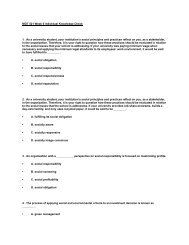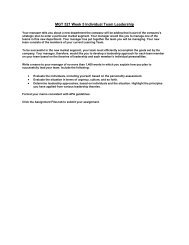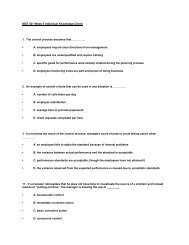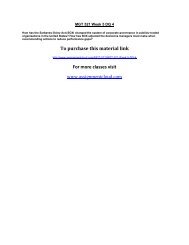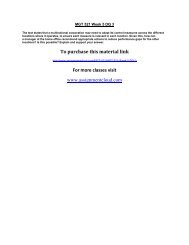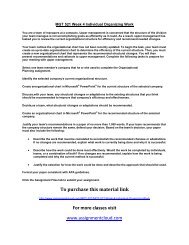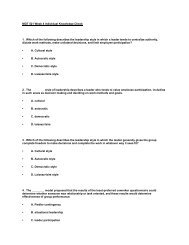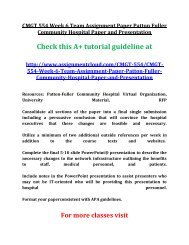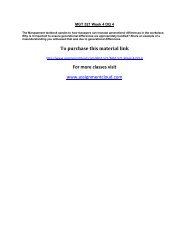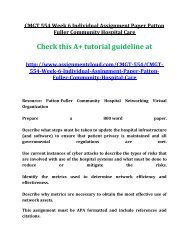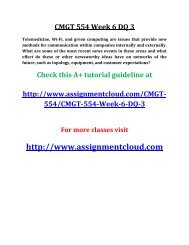MGT 521 Week 3 Individual Knowledge Check
Create successful ePaper yourself
Turn your PDF publications into a flip-book with our unique Google optimized e-Paper software.
<strong>MGT</strong> <strong>521</strong> <strong>Week</strong> 3 <strong>Individual</strong> <strong>Knowledge</strong> <strong>Check</strong><br />
1 . The process of dividing work activities into separate job tasks is known as ________.<br />
<br />
<br />
<br />
<br />
A. work specialization<br />
B. differentiation<br />
C. chain of command<br />
D. span of control<br />
2 . The process of grouping jobs together is known as ________.<br />
<br />
<br />
<br />
<br />
A. departmentalization<br />
B. centralization<br />
C. formalization<br />
D. decentralization<br />
3 . The line of authority that extends from upper organizational levels to lower levels, clarifying who reports<br />
to whom, is known as the ________.<br />
<br />
<br />
<br />
<br />
A. employee power distance<br />
B. unity of command<br />
C. span of control<br />
D. chain of command<br />
4 . Which of the following is a characteristic of a mechanistic organization?<br />
<br />
<br />
<br />
<br />
A. Cross-functional teams<br />
B. Free flow of information<br />
C. Wide spans of control<br />
D. Clear chain of command<br />
5 . Which of the following structures is highly adaptive, loose, and flexible?<br />
<br />
<br />
<br />
<br />
A. Organic<br />
B. Centralized<br />
C. Vertical<br />
D. Mechanistic<br />
6 . Companies would become more ________ if they allowed professionals to set the priorities and allocate<br />
the resources for their departments.<br />
<br />
<br />
A. bureaucratic<br />
B. mechanistic
C. diversified<br />
D. organic<br />
7 . In a ________ structure, no clear chain of command exists.<br />
<br />
<br />
<br />
<br />
A. team<br />
B. project<br />
C. mechanistic<br />
D. functional<br />
8 . Which organizational design increases the complexity of assigning people to projects?<br />
<br />
<br />
<br />
<br />
A. Matrix structure<br />
B. Team structure<br />
C. Boundaryless structure<br />
D. Learning structure<br />
9 . In which of the following organizational designs are employees most likely to experience communication<br />
difficulties?<br />
<br />
<br />
<br />
<br />
A. Team structures<br />
B. Matrix structures<br />
C. Project structures<br />
D. Boundaryless structures<br />
10 . A company brings team members together to collaborate on resolving mutual problems that affect each<br />
of their areas. This is an example of the use of ________.<br />
<br />
<br />
<br />
<br />
A. cross-functional teams<br />
B. task forces<br />
C. communities of practice<br />
D. cross-cultural teams<br />
11 . A temporary committee formed to address a specific short-term problem that affects several<br />
departments is known as a ________.<br />
<br />
<br />
<br />
<br />
A. task force<br />
B. community of practice<br />
C. strategic partnership<br />
D. joint venture
12 . Which of the following will help in making communities of practice successful?<br />
<br />
<br />
<br />
<br />
A. Conducting face-to-face meetings, instead of online meetings<br />
B. Having clear accountability and managerial oversight<br />
C. Encouraging members to nurture competing goals<br />
D. Focusing on simple and routine issues that can be easily tackled<br />
13 . The ________ stage in the group development process is complete when members begin to think of<br />
themselves as part of a group.<br />
<br />
<br />
<br />
<br />
A. forming<br />
B. storming<br />
C. norming<br />
D. performing<br />
14 . During the ________ stage of the group development process, a relatively clear hierarchy of leadership<br />
and agreement on the group’s direction emerge.<br />
<br />
<br />
<br />
<br />
A. forming<br />
B. storming<br />
C. norming<br />
D. performing<br />
15 . The ________ stage of the group development process is one in which close relationships develop and<br />
the group becomes cohesive.<br />
<br />
<br />
<br />
<br />
A. norming<br />
B. forming<br />
C. storming<br />
D. performing<br />
16 . In which of the following conflict-management techniques are conflicts resolved by seeking an<br />
advantageous solution for all the parties involved?<br />
<br />
<br />
<br />
<br />
A. Collaborating<br />
B. Compromising<br />
C. Forcing<br />
D. Accommodating<br />
17 . Conflicts can be resolved by withdrawing from them or suppressing them. This conflict-management<br />
technique is known as ________.
A. compromising<br />
B. forcing<br />
C. accommodating<br />
D. avoiding<br />
18 . Which of the following lists are the five conflict-management options available to managers?<br />
<br />
<br />
<br />
<br />
A. Accommodating, Asserting, Avoiding, Compromising, and Cooperating<br />
B. Avoiding, Collaborating, Cooperating, Compromising, and Forcing<br />
C. Accommodating, Avoiding, Collaborating, Cooperating, and Forcing<br />
D. Accommodating, Avoiding, Collaborating, Compromising, and Forcing<br />
19 . Behavior patterns expected of someone occupying a given position in a social unit is called a ________.<br />
<br />
<br />
<br />
<br />
A. role<br />
B. status<br />
C. profile<br />
D. persona<br />
20 . Which of the following is a negative aspect of group norms?<br />
<br />
<br />
<br />
<br />
A. Being part of a group has the ability to increase an individual's antisocial actions.<br />
B. The most widespread norms are those related to dress codes.<br />
C. Groups become dysfunctional when they maintain strict norms.<br />
D. Norms do not influence employees' performance.<br />
21 . Which of the following is an accurate statement regarding status systems?<br />
<br />
<br />
<br />
<br />
A. Anything can have status value if others in the group evaluate it that way.<br />
B. Status is a weak employee motivator even though it has behavioral consequences.<br />
C. Status can only be formally conferred on individuals.<br />
D. Status systems are independent of aspects such as prestige and grading.
To purchase this material link<br />
http://www.assignmentcloud.com/<strong>MGT</strong>-<strong>521</strong>/<strong>MGT</strong>-<strong>521</strong>-<strong>Week</strong>-3-<strong>Individual</strong>-<strong>Knowledge</strong>-<strong>Check</strong><br />
For more details visit<br />
www.assignmentcloud.com



